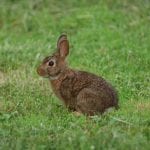Scientific Facts
| Common Name: | English Lop |
| Scientific Name: | Oryctolagus cuniculus |
| Life Span: | 5 to 7 years |
| Size (Adult): | Medium |
| Weight (Adult) | 9 to 10.5 pounds |
| Habitat: | Human homes, meadows, gardens, and yards |
| Body Shape: | Semi-arch or mandolin |
| Country of Origin: | England |
Physical Description

The English lop is known as a fancy rabbit breed that was developed in the UK during the 19th century using selective breeding techniques. Experts say that the English lop may be the first rabbit breeds that were developed by humans and the oldest domestic rabbit breeds.
The English lop is a medium to large-sized rabbit breed with an average of 11 pounds weight. It is so-called because of its huge and long lop ears, a large head and a large body. The ears of the English lop is the most significant part of the rabbit’s body. It falls on each side of its head. The ears have a round shape and do not have any points on end. Also, according to standards, the ears of the English lop must be 32 inches in length from tip to tip, which is the longest of all rabbit breeds.
The ears of the English lop stop growing by the time the rabbit has reached 5 months of age. Meanwhile, experts also said that male rabbits could grow as much as an inch of their ears as their skull matures. The rabbit must have a wide nose, no visible crown, and strong shoulders. The body is round over the flanks and the hips.
The head of the English lop is huge and has wide-set eyes. The body has a mandolin shape while the feet are long and straight in the front. The tail is straight and should not be twisted.
Coat and Colors
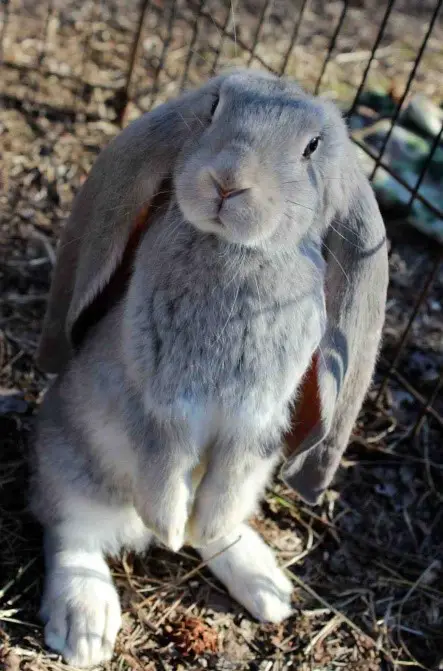
The coat of the English lop should be smooth, soft, and warm to the touch. The ears, in particular, should be covered with soft fur. Their coat has a flyback feature and is smooth and short plus easy to maintain.
English lops come in solid colors and broken colors (broken colors are broken by whites). This breed can come in several colors, such as black, orange/fawn, chinchilla, blue, agouti/opal, Red Eyed White, and blue and black torts. The ARBA or the American Rabbit Breeder’s Association permits recognized colors to be in solid or broken than pointed whites.
History of the Breed
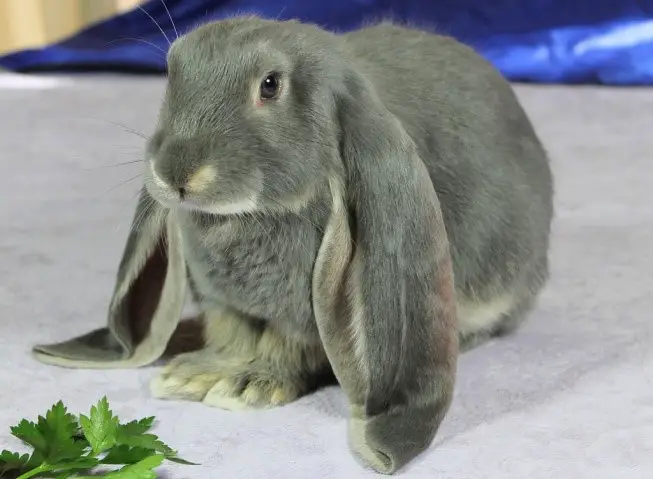
The English Lop is the first lop to breed. It was developed in the United Kingdom in the 19th century for the show as a fancy breed. At that time, fancy animal breeds are the most popular in trade shows and exhibitions. The English lop was the most popular pet during the Victorian era. This also marked the departure of the role of rabbits as meat, wool, and fur source. The English lop was later bred with other breeds in Europe, and this started other popular lop breeds like the French lop and the Holland lop. The French lop was a cross of the English lop and the Flemish Giant while the Holland lop was a mix of the French lop and a Netherland Dwarf.
A dark history of how the English lop breed started is a less known story. It is said that the very first English lop was from Africa, and a variety of this breed came to the market in mid-1800 in England and then soon to the US by trade ships. It was also said that breeders during this time used cruel ways to enhance the length and the quality of the lop’s ears. Some would apply wax on the ears while some stretched it to make them longer.
Fast Facts
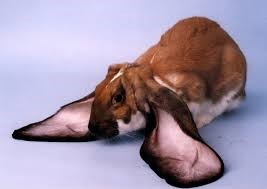
Do you know that adult English lops are known as the “dogs of the rabbit world?” This might be because of the friendly, outgoing, and even funny temperament and behavior of this rabbit breed! This rabbit is perfect for families with young children and also for seniors. But owners have to pay special care and attention to the rabbit’s ears because these could affect the way it moves, runs, and how it is trained. But overall, the English lop is one cute and cuddly pet with a lot of potentials.
Reproduction

The English lop mates and reproduces just like other rabbit breeds. This rabbit breed may start to breed as early as a few months and are able to reproduce any time of the year. When breeding English lops, you must first prepare your breeding area since newborn bunnies are born helpless, blind, and deaf. You need an extra cage or enclosure to secure them.
Rabbits like the English lop are very easy to breed. First, keep the male in a separate cage. Introduce the female to the male’s cage after a week. Doing this will increase the chances of successful breeding. Expect rabbit mating behaviors to begin very shortly!
First, the male will chase after the female. The doe will jump, run, and sometimes stay still while the male will chase after her and then sniff her back. She will respond by running and jumping again if she resists the male or she may lie on her side and allow the male to sniff further. If the female reciprocates, the male will mount her and thrusts in her as well.
The mating act is swift, and when it’s successful, the male may thump his hind legs and will simply let the doe alone. This may happen again after a short while, but you can tell that it’s successful each time if the male leaves the female alone after the act. You may separate the two after a day or two. Place the female inside a separate cage where she can make her nest.
Gestation can take 35 or more days, and soon, the pregnant doe will be ready to give birth. Rabbits line their nests with anything available. You can add fresh hay daily, and she will use this to make the nest. She may also use her fur to create a warm and waterproof nest.
She will deliver 3 to 5 kits. As mentioned, these baby rabbits are born blind, deaf, and vulnerable. The female will nurse her baby only in the evenings while she stays out of the nest in the daytime. Nursing only happens in a short while, and before she leaves the nest, she will cover her babies with hay to protect them.
The little ones will open their eyes after 5 or 7 days and will be out of the nest in just 10 days. Some breeders and pet owners have witnessed there does eating her stillborn or newborns. This is very unusual behavior, and some experts say that there are reasons behind this. The female may not be receiving enough food and fluids, and thus she may resort to eating her young. Some say that eating stillborn tissues and blood is a way for the female to hide her nest from predators.
Fun Facts
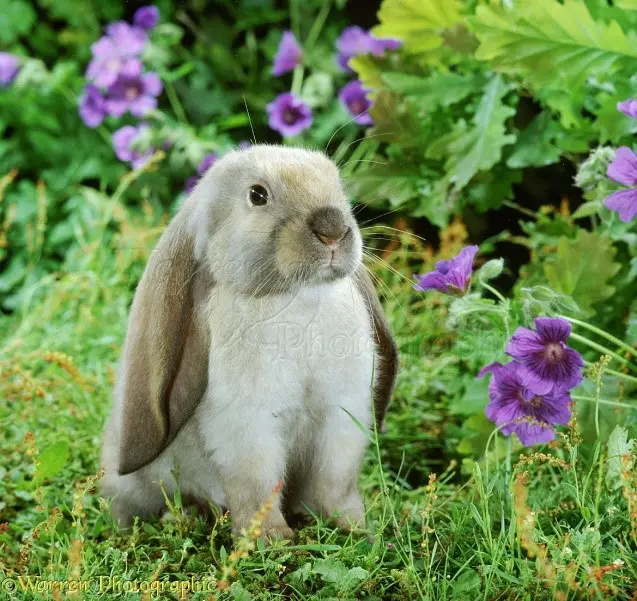
The cute English lop may be the most popular and is a highly photographed breed. This is because of their lovely fur, cute ears, and lovely face. But do you know that you can’t give a rabbit a bath because it will stress them? Even if your rabbit becomes dirty after playing outdoors, you can’t wash them in water. Use a soft, damp towel instead. Wipe the rabbit clean, and don’t forget to clean its ears too. The English lop usually drags its ears everywhere it goes, and this becomes extra dirty.
Personality and behavior
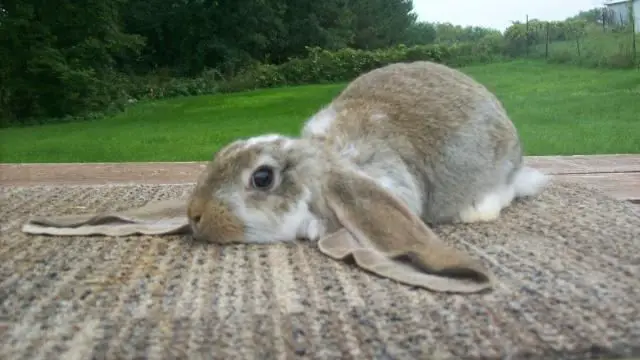
English lops are not just very popular because of their loopy cute ears, but also because of their winning personalities. Despite their large ears that are always dragging alongside their bodies, the English lop is very energetic and curious, especially when they are young.
When picked up, these are calm and laid back, which is why they are best suited for families, especially for families with very young children. It won’t take long for an English lop to warm up to you. Just offer food or treats and it will surely come to you without hesitation.
This rabbit needs a lot of space to move around and playa because they have a lot of energy. This is why it’s better to have an outdoor cage or enclosure rather than a limited indoor space.
Comparable Breeds
The cute and cuddly English lop is comparable to two lovely breeds the American fuzzy lop and the French lop. The American fuzzy lop is a dwarf size rabbit that weighs less than 4 pounds. It has a compact shape with a thick and sometimes long coat. The colors vary for this breed and are known for being playful, curious, active, and very affectionate towards its owner. The American fuzzy lop is fit for indoor rabbit owners as well as for families with kids.
Meanwhile, the French lop is a descendant of the English lop and is a giant rabbit breed. It can weigh up to 15 pounds and has a commercial-type body shape. Its shape does not hinder this rabbit from being affectionate, playful, and active, especially when they are still young. It is a docile breed too and is perfect for singles, seniors and first-time rabbit owners.
Care of English Lops

Taking care of an English Lop is like caring for other breeds. It’s easy once you get the hand of it. Just provide your rabbit the correct diet, the right enclosure, companionship, and medical treatment.
The most important part of any rabbit’s diet is hay. Hay is the bulk of their diet because it makes them full; it enhances digestion and can grind their teeth down. You may also feed your rabbit commercially-prepared food, which has added vitamins and minerals for good health. You may add vegetables and fruits to a well-rounded diet.
Always make sure that your pet is eating the safest kind of food. Protect it from pesticides, toxins, and herbicides by giving it organic fruits and vegetables. Younger rabbits need alfalfa hay because it’s rich in calcium needed for growing bones. Meanwhile, adult English lops may eat legume hay.
are social animals and thus will need companions aside from interacting with their owners. Rabbits raised with constant companions and have regular interactions with their owners are healthier, happier, and are well-rounded rabbits.
English Lops are mostly active in the daytime and tend to sleep in the evenings. Therefore, food should be offered in the morning when they are most active. But leave hay inside their cages all the time.
English lops sleep 8 hours a day and may sleep huddled together to keep warm. And when choosing or constructing a cage or enclosure for your pet rabbits, create a large area where they can eat, play and sleep.
Supplies and Cages
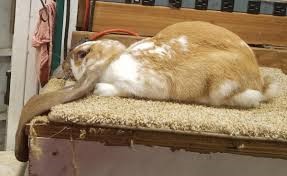
The enclosure for captive English Lops should have a strong frame. The bottom must be removable where the rabbit’s droppings will easily fall. The floor of the enclosure must have soft bedding so that it is comfortable for your rabbit to stay on. A cage that has no tray under it may also suffice, but you need to sweep the floor of the cage regularly to remove droppings and leftover food.
A rabbit hay feeder may be attached to the side of the enclosure. Fill this with hay so your rabbit can just take from the feeder to eat. For the cage bedding, you must only use hay, wood pellets, or pelleted horse bedding. Don’t use newspapers, paper towels, or brown paper bags because these can easily tear up and get wet.
Clean and maintain the rabbit cage weekly. To clean the cage, first, remove your pets and place these in a safe and clean enclosure. You must use only a safe cleaner or natural cleaning product such as white vinegar, baking soda, or lemon juice to clean the cage. Do not use household cleaners because these may have toxic ingredients or chemicals that can be dangerous to your pet’s health.
You must have a separate or extra cage if you plan to breed baby English Lops. Baby rabbits are born naked, deaf, and blind. These need a warm enclosure to keep their bodies at the right temperatures. Use a smaller cage with a cage lamp or lighting to keep kits dry, warm, and safe.
English lops are not into chewing things but can do this behavior if it’s boring. If these rabbits are kept indoors, these will chew on anything that’s made of wood, even wooden furniture. This rabbit can also chew on electrical wiring, and this can instantly electrocute your pet and kill it. So, to prevent accidents, provide hay or chew toys inside the cage. Rabbit-proof your home before freeing your pet indoors.
Health Concerns
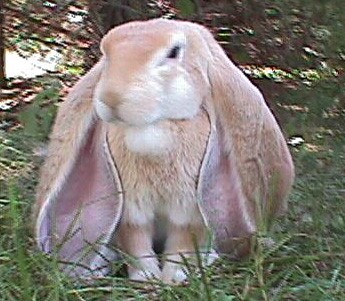
An English lop is known as a healthy breed and is not affected by any specific disease. Just like most captive breeds, the most common conditions that the English lop may be affected with are pests such as mites, ticks, and fleas. These are naturally found in their environment.
Meanwhile, this breed is not immune to common rabbit diseases. You must monitor your rabbit’s health and temperament because any weird behavior can be due to an illness. So, as early as possible, take your pet rabbit to the vet for vaccinations.
A vet will also conduct tests to assess the overall health and development of your rabbit. Young rabbits also have sensitive digestive systems and, therefore, may be prone to different health conditions of the digestive system such as enteritis, bloat, and stasis. If you suspect digestive system problems, take your pet to the vet at once.
Also, watch out for ear or fur parasites. The most common parasites that affect rabbits are mites, fleas, and ticks. Usually, rabbits with these parasites have poor hygiene and are kept in dirty and unkempt enclosures.
Another very important part of the health care of rabbits is deworming. Your English lop must be treated for worms at least once a year and should be done during springtime and fall. All rabbit breeds must be dewormed. This is easily done by using a pea-sized amount of deworming paste. Put this in the rabbit’s mouth, and this will lick and swallow the medication until it’s gone. You should follow the dose according to the product container for the best results. Consult your vet for the best brand of deworming paste for your pet.
Be a cautious pet owner by monitoring your rabbit for any signs of illness such as poor appetite, nasal and eye discharges, diarrhea, constipation, and vomiting. Be mindful of other unusual symptoms like an unsteady gait, restlessness, grating of the teeth, and sleeping longer hours because these could be signs of a serious medical or health condition.
Dental Care
An English lop’s teeth will continue to grow, and sometimes, their teeth can grow to extreme lengths that this can pierce their mouths and gums. This can cause extreme pain and discomfort for a rabbit. Therefore, it’s your job to monitor your rabbit’s teeth as well.
You can help your rabbit keep its teeth short by offering hay. This files down the rabbit’s teeth naturally as it chews. You may also place pieces of wood, wooden baskets, or other cage accessories that can file a rabbit’s teeth. You must diligently monitor your rabbit’s dental health to save on expensive dental bills.
Spaying or Neutering
Be a responsible pet owner and control the rabbit population by spaying and neutering your pet. Do you know that if you overlook rabbit populations, you may end up having a lot of rabbits in just a year? Rabbits can become pests in homes, gardens, and farms, and this is why spaying and neutering should be done for all rabbit pets.
Some veterinarians wait until the rabbits are six months old to spay or neuter them. Bucks are also neutered at a young age because experts say that this reduces aggression. Some vets may perform the procedure as early as three months. Consult your vet for any questions about spaying and neutering and concerns about post-operative care for your pet.
Grooming

English Lops have short to moderately short coats. Brush the fur to keep it clean, shiny, and free from pests. Use a small brush at least once or twice a week. Also, grooming should be done more frequently during their molting period. This will prevent wool blocks and will keep the rabbit from ingesting their fur. Fur cannot be digested, and this can accumulate in the digestive tract causing blockage and other complications. Regular brushing can avoid these complications.
Trim your rabbit’s nails regularly and check its mouth for overgrown teeth. You may ask the vet to do this for you if you don’t have tools for cutting or if you’re not comfortable with cutting the rabbit’s nails and checking its mouth.
Availability – Where to Get One?
The cost of purchasing an English Lop may depend on whether you are buying a rabbit from a breeder or a retailer. The price will vary whether you are getting a rabbit for show or as a pet. You can expect the price to vary depending on the gender, size, coat quality, and appearance, especially the prominence of the rabbit’s ears.
When looking for a reliable breeder, be sure that you are getting a healthy one, with no genetic disorder. Purchase only from reliable breeders that raise healthy English lops. This breed is often seen in trade fairs and farm events. This is also popular in shows and contests sponsored by the ARBA.
How to Care for an English Lop
This is a summary of how to care for an English lop rabbit breed. Caring for an English lop is similar to caring for other breeds. You must consider your pet’s diet, housing, companionship, and vet care.
The most important component of your rabbit’s diet is hay. This is important in their diet so they can grind their growing teeth, to keep their digestive system healthy and for regular bowel movements. Aside from hay, you may also use commercially-prepared pellets or rabbit food, vegetables, and fruits. You may also give rabbits food found in their natural habitats such as grasses, twigs, birch, maples, and weeds but make sure that your sources are organic or free from chemicals like pesticides, herbicides, and other toxins.
Leave fresh water and hay inside the rabbit’s cage. Place water in a large, heavy shallow dish so your rabbit can drink from it and won’t knock it over as it moves inside its cage. You may offer rabbit treats when training or teaching your rabbit basic tricks.
Captive-bred rabbits can become calm, friendly, and docile when you invest time to train them. You must take the time to train and interact with your pet daily. Take note that captive rabbits are social animals and will need a companion or companions. Consider getting two, three, or more rabbits instead of getting just one pet.
If you lack the resources, space, and patience to care for two or more rabbits, then a pet rabbit may not be the best one for you. Take note that your pet can grow healthy, have a good temperament, and adapt a docile behavior when it socializes with fellow rabbits and of course, you.
And finally, don’t overlook professional health care. Take your pet to the vet because it needs vaccinations, tests, and good health before it can be allowed to associate with other rabbits, pets, and people. You must learn the different signs of illness in rabbits, and if you spot any symptom, take it to the vet at once for proper care.
FAQs
How do you tame a rabbit?
This depends; are you referring to a wild rabbit or a captive rabbit? A wild rabbit cannot be tamed, and you must not take a wild rabbit to tame it. Meanwhile, you can train a captive-bred rabbit instead because these rabbits have a docile behavior and are calmer than wild rabbits. You need to be patient and use food or treats to train a rabbit.
Will an English lop eat fruits and vegetables?
Yes, English lops can eat fruits and vegetables. You may also feed your English lops commercially-prepared pellets or rabbit food, which contain vitamins, minerals, and other nutrients your pets need.
Will English lops eat their poop?
Yes, just like all rabbit breeds, English lops will eat their poop because these still have nutrients in them. And after eating their poop once, they won’t do it the second time. You can prevent this by removing their droppings as soon as they poop.
Can you keep an English lop as a pet?
Yes, you can keep an English lop as a pet because it is docile, calm, and sweet. It is a good pet for families even for families that have small children because it’s easy to train and will remain calm even when held by someone new to petting rabbits.
How do you take care of baby English lops?
If you want to take care of English lops, put the kits in a comfortable and warm enclosure. Feed these rabbits soft pureed food and keep these safe from predators and also from your house cat or pet dog.
Can you leave an English lops indoors to play inside your home?
You may allow a rabbit to stay indoors but only under constant supervision. You can use a portable perimeter fence to protect areas that the rabbit can’t go. Take note that you have to rabbit-proof your home first before you let your rabbits lose.
Are English lops carnivorous?
No, rabbits like the English lop are not carnivorous and are herbivores, which means that these won’t eat meat. It will only eat plants or plant parts such as leaves, flowers, twigs, stems, seeds, and roots.
What do English lops eat?
English lops are herbivorous, and this means that these will only eat plants. These will eat plant parts such as roots, bark, seeds, weeds, flowers, and leaves, and in captivity, these will eat commercially-prepared rabbit food or pellets, fruits, and vegetables.
Are English lops endangered?
No, English lops are not endangered. The English lop breed is available from local and international breeders as well as in pet shops and also in human homes as pets.
Can you keep two or more English lops inside an enclosure?
Yes, you can keep two or more rabbits in one cage as long as their cage is large to keep the number of rabbits you intend to have as pets. Take note that the cage should be large, comfortable, and safe so your pets can comfortably stay inside it.
Do you place an English lop’s cage indoors or outdoors?
You can place a rabbit’s cage indoors or outdoors, understand the pros and cons of each. You may place the cage indoors to protect it from the elements, but most indoor enclosures are small and may not be enough for a large, adult English lop more so two or more rabbits. When you place your cage outdoors, the rabbits may need to bear the cold and even the hot sun, but at least they will have a large area for playing, running, and socializing.
Can rabbits survive the cold?
Yes, rabbits may stay out in the cold and survive by foraging food that’s found under the snow. Rabbits will use their short legs to dig out of the snow and eat roots, shrubs, berries, and many more.
Can English lops remain outdoors?
A pet English lop may be allowed to stay outdoors but under constant supervision, and you must rabbit-proof your yard first. A portable perimeter fencing is a good way to limit the area where your pet can run and roam around. Bury the poles of the fence to prevent the rabbit from digging out and escaping.
What happens when the teeth of English lop grow longer?
When the teeth of the rabbit grow longer, these can pierce the mouth and gums, causing extreme pain, and this can affect its appetite and temperament. This is why your pet rabbit must see a dentist regularly. You can also help by feeding it hay since this can grind their teeth shorter as the animal chews.
Are English lops bites dangerous?
Yes, English lop bites and the bite of all rabbits are dangerous because of rabies. Also, rabbit teeth are huge, and this can tear off the flesh, which can lead to an infected open wound when not treated at once.
Can you prevent an English lop from eating his poop?
You can stop a rabbit from eating poop by removing the poop right away, but of course, you can’t watch your rabbits all day! No matter what, these animals will still eat their dropping because this still has nutrients in them.
How large should an English lop’s cage be?
One English lop must be placed in a large enclosure because of its size. If you have two large rabbits, double this space. Don’t overlook the size and make sure that your rabbits have enough space to play, eat, and sleep.
Can rabbits see in the dark?
Yes, rabbits have good vision at night. This is why some species prefer to look for food at night. Rabbits such as the English lop also have a good sense of smell and hearing to easily recognize predators near the area so it can hide or protect itself right away.
Are English lops territorial?
English lops may become territorial when these are kept in a small enclosure. Males can develop aggressive behavior and may be threatened with other males, especially in the breeding season. These rabbits can bite, scratch, and kick their opponents to establish hierarchy.
Will a mother English lop eat her young?
Some rabbit species can eat their young. Breeders are still looking for answers as to why the mother does this, but if you spot the mother English lop eating her young, remove it from the nest and don’t let it breed again.
Does it hurt when an English lop hits you with its hind legs?
Yes, English Lops have very sharp claws, especially on its back feet. This rabbit can kick very hard with its hind feet, which can inflict damage. The rabbit will only do this when it feels threatened or when it feels afraid.
Can rabbit diseases affect humans?
Some rabbit diseases can affect rabbits, while some can affect humans. If your rabbit is sick, take it to the vet fast. You must learn how to check for signs of illnesses such as poor appetite, diarrhea, constipation, sneezing, difficulty in breathing, and behavioral changes.
Do English lops have good hearing?
The English lop’s huge ears are not just for show; it also has a keen sense of hearing. It can hear its predators from far away, and thus, it still has time to jump and escape from it.
Will your pet rabbit survive the cold?
Some rabbits can survive the cold and will find food under the snow. Some rabbits can change their coat color to adapt to the winter weather, but some may not survive the cold, especially desert rabbits.
Can you position the cage of English lops near other rabbit pets?
Yes, you can do this without any effect on the behavior of this rabbit because it is calm and docile. This is the setup in most pet shops and stores. English lops are very friendly, docile, and calm, so this won’t be a problem.
What do you do with abandoned baby rabbits?
If you’re certain that kits are abandoned in their nests, call animal service for help. You should never get baby rabbits from the wild as pets only captive-bred rabbits.
How many rabbits can you keep as a pet?
You can keep three or more rabbits as a pet as long as you place these in a suitably large cage or enclosure to keep these happy and comfortable. Keeping only one rabbit will make it lonely and can make it depressed and affect its health.
Will rabbits eat insects?
No, rabbits will not eat insects. This will eat only plant and plant parts, commercially—prepared rabbit food, fruits, and vegetables. Make surer to provide organic produce to avoid chemicals and toxins, which can only harm your pet.
Are rabbits cannibals?
Eating their young can be seen in some rabbit breeds. Experts say that this is because the female is hungry or thirsty, and it does not have anything to drink or eat. Also, experts say that this is a way to remove any traces of tissue, blood, and smell in the nest, especially when a baby is stillborn.
Will English Lops learn to recognize their owners?
Some rabbit owners proudly say that their pets can recognize them and can tell if they are being handled by them or by another person. This can happen if you train your rabbit to be trusting, easy-going, and calm. Train it daily so it will be able to recognize you.
Can pet rabbits tolerate children?
If depends on the rabbit breed. Some rabbits are very skittish and don’t want to be held by young children and by inexperienced handlers. Some rabbits are calm, docile, and friendly and will love to be held and petted even by young children. So choose a calm and docile breed if you have young children in your family.
Where do wild rabbits sleep?
Rabbits may sleep in holes or burrows in the wild. Some breeds learn how to dig holes as deep as several inches into remaining there all day and into foraging food at twilight. Rabbits can also sleep in their dens and nests. Meanwhile, in captivity, they must live in an enclosure that can accommodate a group of rabbits, which makes them safe and secure from predators.

